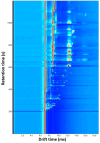Detection of Adulterated Oregano Samples Using Untargeted Headspace-Gas Chromatography-Ion Mobility Spectrometry Analysis
- PMID: 38397493
- PMCID: PMC10888469
- DOI: 10.3390/foods13040516
Detection of Adulterated Oregano Samples Using Untargeted Headspace-Gas Chromatography-Ion Mobility Spectrometry Analysis
Abstract
Oregano is often adulterated for economic reasons. This fraud mainly consists of adding other species with lower commercial value, such as olive leaves. To ensure the authenticity of oregano, an analytical method based on the analysis of the volatile organic compound (VOC) profile obtained by headspace gas chromatography coupled to ion mobility spectrometry (HS-GC-IMS) was developed and validated. Samples of ecological Mediterranean oregano adulterated with different percentages of two types of olive leaves (cornicabra and manzanilla) were studied using a non-targeted analysis. Moreover, a total of 30 VOCs were identified in the analyzed samples, and 24 compounds could be quantified using calibration curves based on Boltzmann's equation. A chemometric model based on orthogonal partial least squares discriminant analysis (OPLS-DA) was used to detect the adulterated oregano samples, obtaining a 100% validation success rate, and partial least squares (PLS) analysis was used to quantify the percentage of adulterant. Finally, the proposed methodology was applied to 15 commercial oregano samples, resulting in two of them being classified as adulterated with 31 and 43% of olive leaves, respectively.
Keywords: adulteration; gas chromatography; headspace; ion mobility spectrometry; oregano.
Conflict of interest statement
The authors declare no conflicts of interest.
Figures




Similar articles
-
Rapid Detection of Antibiotic Mycelial Dregs Adulteration in Single-Cell Protein Feed by HS-GC-IMS and Chemometrics.Foods. 2025 May 12;14(10):1710. doi: 10.3390/foods14101710. Foods. 2025. PMID: 40428490 Free PMC article.
-
Untargeted headspace gas chromatography - Ion mobility spectrometry analysis for detection of adulterated honey.Talanta. 2019 Dec 1;205:120123. doi: 10.1016/j.talanta.2019.120123. Epub 2019 Jul 5. Talanta. 2019. PMID: 31450393
-
Adulteration detection of essence in sesame oil based on headspace gas chromatography-ion mobility spectrometry.Food Chem. 2022 Feb 15;370:131373. doi: 10.1016/j.foodchem.2021.131373. Epub 2021 Oct 9. Food Chem. 2022. PMID: 34788966
-
Explorative study for the rapid detection of adulterated surimi using gas chromatography-ion mobility spectrometry.Food Chem. 2024 May 1;439:138083. doi: 10.1016/j.foodchem.2023.138083. Epub 2023 Nov 29. Food Chem. 2024. PMID: 38043278
-
Authenticity assessment of ground black pepper by combining headspace gas-chromatography ion mobility spectrometry and machine learning.Food Res Int. 2024 Mar;179:114023. doi: 10.1016/j.foodres.2024.114023. Epub 2024 Jan 13. Food Res Int. 2024. PMID: 38342542
Cited by
-
Assessing the Authenticity and Quality of Paprika (Capsicum annuum) and Cinnamon (Cinnamomum spp.) in the Slovenian Market: A Multi-Analytical and Chemometric Approach.Foods. 2025 Jun 30;14(13):2323. doi: 10.3390/foods14132323. Foods. 2025. PMID: 40647074 Free PMC article.
-
Rapid Detection of Antibiotic Mycelial Dregs Adulteration in Single-Cell Protein Feed by HS-GC-IMS and Chemometrics.Foods. 2025 May 12;14(10):1710. doi: 10.3390/foods14101710. Foods. 2025. PMID: 40428490 Free PMC article.
References
-
- Kintzios S.E. Profile of the Multifaceted Prince of the Herbs. In: Kintzios S.E., editor. Oregano: The Genera Origanum and Lippia. CRC Press; London, UK: 2002. pp. 3–10.
-
- Dried Oregano (Origanum vulgare L.) ISO; Geneva, Switzerland: 2015.
-
- Council of Europe . European Pharmacopoeia. Council of Europe; Strasbourg, France: 2005. Oregano Monograph 01/2005:1880; pp. 2155–2156.
-
- Massaro A., Negro A., Bragolusi M., Miano B., Tata A., Suman M., Piro R. Oregano Authentication by Mid-Level Data Fusion of Chemical Fingerprint Signatures Acquired by Ambient Mass Spectrometry. Food Control. 2021;126:108058. doi: 10.1016/j.foodcont.2021.108058. - DOI
Grants and funding
LinkOut - more resources
Full Text Sources
Miscellaneous

